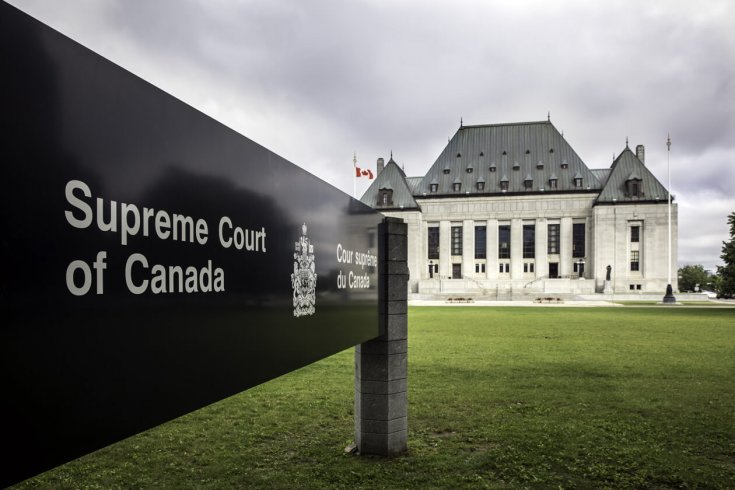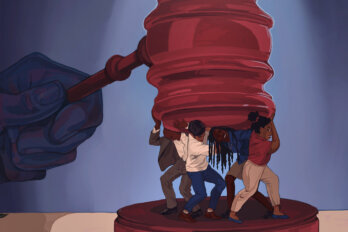With all of the attention being paid to the United States Supreme Court nomination battle, one could be forgiven for overlooking the fact that our very own Supreme Court of Canada started a new term this month. And the court’s docket is already filling up with cases that raise consequential and difficult questions about matters as diverse of warrantless police searches, international law, class actions, deference to government, and press freedom.
As the final court of appeal in Canada, the Supreme Court’s nine judges get the last judicial word in resolving disputes, interpreting government legislation, and determining whether government conduct is constitutional. The court typically receives somewhere in the range of 500 requests for “leave” (or permission for a case to be heard) each year, yet it only hears somewhere between forty and seventy cases. With few exceptions, the court’s members have almost complete autonomy in selecting which appeals they want to hear. Their selections reflect cases of public importance; for example, cases where the existing state of the law needs to be clarified or corrected or where a novel legal issue needs to be addressed.
Of course, not all cases are created equal. Each year, a small handful of appeals raise questions with especially high stakes, both in terms of the development of the law and in terms of having potentially broad consequences for Canadian society. Of the forty-three appeals currently scheduled to be heard by the Supreme Court between now and February 2019, here are five cases that stand out as meeting that description.
1. R. v. Le
Criminal-law appeals are the single biggest category of cases the Supreme Court hears, accounting for anywhere between 25 to 40 percent of the court’s docket. One of the most important criminal-law appeals in this upcoming term is R v. Le, which raises important questions about the type of privacy interests protected under Section 8 of the Canadian Charter of Rights and Freedoms (which generally protects against the ability of police to search one’s person or property without a warrant).
The appellant, Tom Le, was socializing with friends in the backyard of a townhouse rented by the mother of one of Le’s friends, Dixon. The townhouse was located in a Toronto-area housing co-op facing a high level of violent crime. That same evening, police officers out looking for two suspects were pointed to the townhouse area by a security guard. Without a warrant, the officers walked into the backyard through an opening in the fence and started asking Le and his friends questions. When the officers asked what he was carrying in his bag, Le bolted. A brief foot chase ensued. Le was arrested. Police searched his bag and found a loaded handgun and thirteen grams of crack cocaine.
At trial, Le argued the police violated his Charter rights to be free from unreasonable search, and thus the resulting firearm and drug evidence should be excluded. Both the trial judge and a majority of the appeal court judges disagreed, finding that as “a mere transient guest” in the backyard, Le’s claim to privacy was weak. The lone dissenting appeal court judge, Justice Lauwers, saw things differently. He concluded that “invited presence alone is sufficient to give rise to a reasonable expectation of privacy” and that it made little sense to afford Dixon (who lived in the townhouse) full Charter protection while giving Le, as a guest, none.
Le is an important case because it will clarify the extent to which the Charter protects against police intruding on property where one expects to have privacy—even if they do not have exclusive control or ownership over that property. A decision in Le’s favour would give invited guests in a house a measure of protection against warrantless police searches. It could also mean strengthened protections against warrantless police searches for those living in communal, subsidized, or social housing. Seen in this light, the case raises important questions about how to ensure Charter protections for racialized and marginalized groups. As Justice Lauwers put it: “I doubt that the police would have brazenly entered a private backyard and demanded to know what its occupants were up to in a more affluent and less racialized community.”
2. Nevsun Resources Ltd. v. Gize Yebeyo Araya et al.
The court rarely wades into the murky waters of international law, but when it does, the results are almost always newsworthy. For example, in the 2014 case of Kazemi estate v. Islamic Republic of Iran, the court issued a much-publicized ruling that Iran was immune from a civil lawsuit in Canada brought by the relatives of photojournalist Zahra Kazemi, who were seeking damages for Kazemi’s abuse and death in a notorious Tehran prison at the hands of Iranian authorities. This term’s appeal in the case of Nevsun Resources Ltd. v. Gize Yebeyo Araya will likely generate as much attention.
The allegations in the Nevsun suit are disturbing. The plaintiffs are Eritrean refugees who, as conscripts in an Eritrean military program, say they were forced to work at a gold, copper, and zinc mine in their native country. During construction of the mine, the plaintiffs allege that the “peremptory principles of international law”—including some of the most basic prohibitions against the use of forced labour, slavery, and torture—were violated. They allege that Nevsun, a Canadian mining company that owns a majority stake in the mine, was complicit in these violations by ordering, assisting, acquiescing to, or failing to prevent the conduct.
As part of their case, the plaintiffs are demanding damages from Nevsun for breaching basic principles of international law. Similar claims have been and have failed before. But those claims were against countries and were dismissed because foreign states are generally immune from proceedings in Canadian courts. (The Kazemi-estate ruling exemplifies the doctrine of “state immunity” preventing a foreign state from standing trial in Canada.)
The Nevsun appeal is unique because, although the underlying conduct involves a foreign state, the defendant itself is a private company, making the applicability of state immunity principles uncertain. State immunity is generally justified as a natural corollary of state sovereignty: one country cannot stand in judgment over the sovereign acts of another. Does this rationale justify extending immunity to private companies that align themselves with the state as well? That is a key question the Supreme Court will have to answer in the Nevsun case.
Nevsun’s efforts to have the plaintiffs’ claims struck prior to trial were unsuccessful. It now seeks to have the Supreme Court overturn those decisions. Given the novelty of the case, whatever the Supreme Court decides will be closely watched across the common-law world. The outcome is difficult to predict, particularly since only three members of the current court were involved in deciding the Kazemi-estate appeal (and one of those members, Justice Abella, disagreed with the majority and would have allowed the Kazemi lawsuit to proceed.) If the court signals that these kinds of claims against Canadian companies for conduct abroad are viable, then this could usher in an era of increased accountability by allowing aggrieved plaintiffs to have alleged breaches of international law tested in a Canadian courtroom.
3. Pioneer et al. v. Godfrey
Class-action lawsuits often have broad ramifications. With few exceptions, their resolution either requires dismissing the case brought by the plaintiff “class”—normally thousands if not tens of thousands of people who have all bought a certain product or used a certain service—or having the defendant corporation pay out a significant amount of money to satisfy those claims. Courts are often forced to choose between denying thousands of people their day in court or having companies pay out multimillion-dollar sums in damages.
Given the stakes, it is not surprising that the court generally hears at least one class-action case each term. One significant class action appeal will be Pioneer v. Godfrey, where the court will decide on a price-fixing conspiracy. (In these types of cases, defendant companies are alleged to have agreed among themselves to sell products at certain prices, thereby reducing competition and raising prices for consumers.)
The Pioneer case involves an alleged global price-fixing cartel comprised of at least forty-two defendant companies that conspired to set prices for optical-disc drives and the products that contained them (these devices are used with laptops or desktops to play DVDs and CDs). Most members of the plaintiff class bought drives made or supplied by one of the defendant companies.
Before these extraordinary allegations are tested in a full trial, a court must first “certify” the case as a class action. The certification process gives defendant companies an important opportunity to end, or at least limit, the lawsuit at an early stage if they can convince the court that it is “plain and obvious” some or all of the allegations made against them cannot succeed.
That is what some of the defendants in Pioneer are trying to do. They have sought the dismissal of claims brought by a group of so-called umbrella purchasers. Unlike other class members, these purchasers did not buy optical-disc-drive products from alleged cartel members but from companies outside the cartel (and not involved in the lawsuit).
The defendants say they cannot possibly be held liable for what somebody paid a company that had nothing to do with the alleged cartel and set a price independently of any agreement with the cartel. But the umbrella purchasers see things differently. They argue that the impact of the price-fixing conspiracy was so significant that it raised prices across the broader marketplace for optical-disc drives—including those sold by innocent companies that played no role in the conspiracy itself. These consumers want the members of the cartel to bear financial responsibility for these higher prices too.
The viability of umbrella purchaser claims has been hotly contested in Canadian courts. Defendant companies have fiercely resisted these claims since they often mark a massive expansion in who can join a class action—and thus how much would have to be paid in order to settle a class action. Plaintiff-side class action lawyers have pursued them with some vigour with the same reason.
The results have been mixed, if not contradictory. The British Columbia Court of Appeal certified the umbrella-purchaser claims, rejecting the argument that it was “plain and obvious” they would fail. Meanwhile, some Ontario courts have refused to certify similar claims, citing the spectre of nearly unlimited liability for defendants if they were allowed to stand. The Supreme Court will have to choose between these competing approaches when it hears the Pioneer case this fall.
4. Bell and NFL v. Canada (Attorney General of Canada); Vavilov v. minister of citizenship and immigration
The cases before the court this term with potentially the most far-reaching impact come from two equally unlikely sources.
The first is the Canadian Radio-television and Telecommunication Commission’s 2016 decision to end the decades-old regime of “simultaneous substitution” during the Super Bowl, which prevented Canadians from being able to watch US commercials. The CRTC made this decision after a public consultation brought complaints from Canadians who wanted to watch US Super Bowl commercials. The decision was met with objections by the NFL and Bell Canada (which has the exclusive broadcasting rights to the Super Bowl in Canada). After losing an initial appeal before the Federal Court of Appeal, both the NFL and Bell are now challenging the CRTC’s decision before the Supreme Court.
The second case involves Alexander Vavilov, a twenty-four-year-old man who was born in Canada and for many years assumed he was a Canadian citizen. That all changed in July 2010. While Vavilov was living with his parents in the United States, armed FBI agents entered the family home and arrested his parents for being Russian spies. Vavilov had no idea that his parents were spies. (The sensational story of the Vavilov family served as the inspiration for the television series The Americans.)
Back in Canada, the registrar of citizenship cancelled Vavilov’s citizenship. Although the normal rule is that someone born in Canada is a Canadian citizen, the registrar found that Vavilov fell into an exception for those born to parents who were “employees of a foreign government.” Vavilov was successful in having the registrar’s decision overturned by the Federal Court of Appeal, but the minister of citizenship and immigration is now appealing that to the Supreme Court.
At first glance, the CRTC and Vavilov cases appear to have little in common. But at their core is a concept called “judicial review”—the process of having courts review the lawfulness of actions by state agencies and government decision makers.
The sheer scope and scale of decision makers subject to judicial review is hard to overstate. Cabinet ministers, the Immigration and Refugee Board, the National Energy Board, human rights tribunals, regulatory colleges, workplace safety tribunals, landlord and tenant boards, bureaucrats reviewing permit applications—all of these decision makers are affected by the law of judicial review.
To understand the potential importance of the CRTC and Vavilov decisions, one must first understand a fundamental tension in the law of judicial review. On one hand, courts are required to exercise their role as final arbiters of the lawfulness of state conduct—including conduct carried out through administrative agencies like the CRTC or administrative decision makers like the registrar of citizenship. On the other hand, courts recognize the wisdom in providing appointed experts a degree of autonomy and independence when it comes to making decisions within their field of expertise.
The tension plays out most dramatically in a debate over what is called the “standard of review.” Think of this as the lens through which courts will review rulings of administrative agencies or decision makers. As the law stands, reviewing courts have two options. They can either apply a “correctness” standard, closely examining if decision maker’s analysis lines up with how the court itself would have decided the matter, or a more lenient “reasonableness” standard, where the court stands back and affords the decision maker a healthy dose of deference, only interfering if the reasoning process or the outcome is “unreasonable.”
Significant practical implications flow from which standard applies. In a world where reasonableness dominates, courts have a limited role to play in second guessing the conduct of state agencies. Under the correctness standard, however, courts play a much more aggressive role in determining which administrative decisions pass legal muster.
The past decade has seen a steady march toward reasonableness as the standard in almost every case. But in a series of dissenting opinions over the past few years, at least three of the four most recently appointed Supreme Court justices have made it clear they preferred the correctness standard, at least in certain circumstances. Other members of the court have also expressed dissatisfaction with the present state of the law on the standard of review.
It is against this backdrop that the CRTC and Vavilov cases reach the court this fall. The court normally grants leave without commenting on what the parties should focus on in their arguments, but for these appeals, it took the unusual step of inviting the parties to specifically address “the question of standard of review.” This suggests an appetite amongst the justices to seriously reconsider the current balance between correctness and reasonableness. To the extent the legal landscape shifts in favour of a broader correctness standard, such a development would be a powerful tool for those seeking to challenge the decision of administrative agencies in court, marking the end of an era where such agencies enjoyed significant deference and only occasional judicial interference.
5. Marie-Maude Denis v. Marc-Yvan Côté
Freedom of the press has been a hot topic at the Supreme Court lately. Together with two appeals heard last term (Vice v. Her Majesty the Queen and R. v. CBC), Denis v. Côté marks the third press-freedom case to come before the court over the past year.
The Denis appeal will test the strength of the Journalistic Sources Protection Act. The act, which Parliament passed last year to much fanfare, is designed to protect journalists from having to identify their confidential sources in most situations. As the court itself has previously recognized, protecting the identity of sources is critical to journalists’ ability to investigate and report on matters of public interest.
At the same time, the act’s protection is not absolute. Journalists will have to reveal their confidential sources if “the public interest in the administration of justice outweighs the public interest in preserving the confidentiality of the source.” In making this assessment, courts are directed to consider “among other things, (i) the importance of the information or document to a central issue in the proceeding, (ii) freedom of the press, and (iii) the impact of disclosure on the journalistic source and the journalist.”
The Denis case is among the first in Canada to actually consider the act. It arises out of the criminal trial of a former Quebec cabinet minister charged with fraud, corruption, and bribery. The defendant alleges that state agents deliberately leaked information relating to his criminal investigation to journalists, including Denis, who broadcast a report on the issue. He argues these leaks and the resulting publicity have compromised his fair-trial rights and warrant a “stay” of the criminal proceedings. To prove his allegations, he wants Denis to divulge the sources of her information.
Denis has refused, on the basis that she promised her sources confidentiality and is entitled to the protections of the act. The lower courts disagreed on how to interpret and apply the act: the first judge to hear the matter sided with Denis, but on appeal, Denis was ordered to reveal her confidential sources.
Now the matter heads to the Supreme Court. The outcome will be an important indication of how reliably journalist-source confidentiality will be protected moving forward and in what circumstances that principle must yield to competing interests, including a defendant’s ability to pursue allegations of misconduct by the state in the course of a criminal prosecution.





